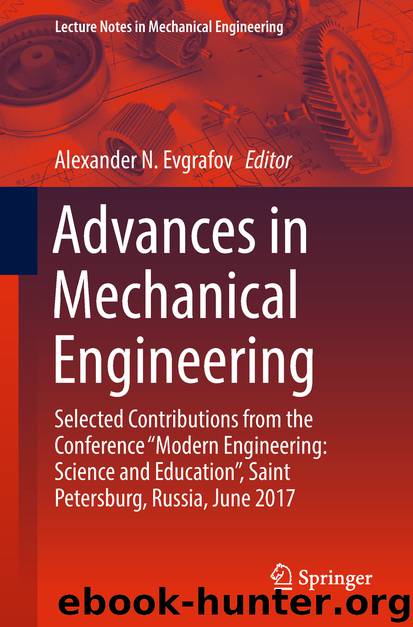Advances in Mechanical Engineering by Alexander N. Evgrafov

Author:Alexander N. Evgrafov
Language: eng
Format: epub
Publisher: Springer International Publishing, Cham
The wavenumber intervals where the negative group velocity is observed are less then in the case of a dry shell (18), due to the adjoint mass of liquid in the first case.
The normalized energy fluxes in the liquid (W) and the shell (S) and the normalized rotating, longitudinal, bending and momentum components () of the energy flux in the shell (28) illustrate the wave processes in the shell-liquid system of the next figures. The energy fluxes of the waves from the left dispersion curve are represented for the frequencies less the bifurcation one alone. The letters “a”, “b”, “c” in the designations of these curves conform to the corresponding sections of the dispersion curves in Fig. 1a.
In Fig. 2b, curves 1, 2, 3 correspond to the energy fluxes , , . The energy flux in the shell is dominant. It is not equal to zero compared to the energy flux in the liquid, and has the opposite sign and the equal module when . The energy flux in the liquid remains positive and is equal to the module for the waves from both branches in the neighborhood of the bifurcation point.
Distribution of the energy flux to different components is shown in Fig. 3, where curves 1 and 2 correspond to the energy flux components and . The main role in the energy transmission belongs to the rotating and longitudinal components of an energy flux, with the first one dominating. Calculations show that the limiting values of the bending and momentum components and are equal to zero at the bifurcation point and are much less than the rotating and longitudinal components in its neighborhood.
Fig. 3The energy flux in the shell and its components (1), (2) for the bifurcating curves
Download
This site does not store any files on its server. We only index and link to content provided by other sites. Please contact the content providers to delete copyright contents if any and email us, we'll remove relevant links or contents immediately.
Deep Learning with Python by François Chollet(12708)
Hello! Python by Anthony Briggs(10010)
OCA Java SE 8 Programmer I Certification Guide by Mala Gupta(9879)
The Mikado Method by Ola Ellnestam Daniel Brolund(9877)
A Developer's Guide to Building Resilient Cloud Applications with Azure by Hamida Rebai Trabelsi(9846)
Dependency Injection in .NET by Mark Seemann(9422)
Hit Refresh by Satya Nadella(8875)
Algorithms of the Intelligent Web by Haralambos Marmanis;Dmitry Babenko(8391)
The Kubernetes Operator Framework Book by Michael Dame(8019)
Sass and Compass in Action by Wynn Netherland Nathan Weizenbaum Chris Eppstein Brandon Mathis(7843)
Test-Driven iOS Development with Swift 4 by Dominik Hauser(7809)
Exploring Deepfakes by Bryan Lyon and Matt Tora(7807)
Grails in Action by Glen Smith Peter Ledbrook(7777)
Practical Computer Architecture with Python and ARM by Alan Clements(7759)
Implementing Enterprise Observability for Success by Manisha Agrawal and Karun Krishnannair(7724)
Robo-Advisor with Python by Aki Ranin(7705)
The Well-Grounded Java Developer by Benjamin J. Evans Martijn Verburg(7657)
Building Low Latency Applications with C++ by Sourav Ghosh(7610)
Svelte with Test-Driven Development by Daniel Irvine(7594)
